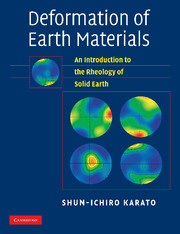Book contents
- Frontmatter
- Contents
- Preface
- Part I General background
- Part II Materials science of deformation
- 4 Elasticity
- 5 Crystalline defects
- 6 Experimental techniques for study of plastic deformation
- 7 Brittle deformation, brittle–plastic and brittle–ductile transition
- 8 Diffusion and diffusional creep
- 9 Dislocation creep
- 10 Effects of pressure and water
- 11 Physical mechanisms of seismic wave attenuation
- 12 Deformation of multi-phase materials
- 13 Grain size
- 14 Lattice-preferred orientation
- 15 Effects of phase transformations
- 16 Stability and localization of deformation
- Part III Geological and geophysical applications
- References
- Materials index
- Subject index
- Plate section
16 - Stability and localization of deformation
Published online by Cambridge University Press: 05 June 2012
- Frontmatter
- Contents
- Preface
- Part I General background
- Part II Materials science of deformation
- 4 Elasticity
- 5 Crystalline defects
- 6 Experimental techniques for study of plastic deformation
- 7 Brittle deformation, brittle–plastic and brittle–ductile transition
- 8 Diffusion and diffusional creep
- 9 Dislocation creep
- 10 Effects of pressure and water
- 11 Physical mechanisms of seismic wave attenuation
- 12 Deformation of multi-phase materials
- 13 Grain size
- 14 Lattice-preferred orientation
- 15 Effects of phase transformations
- 16 Stability and localization of deformation
- Part III Geological and geophysical applications
- References
- Materials index
- Subject index
- Plate section
Summary
Deformation in Earth often occurs in a localized fashion particularly in the lithosphere. The most marked example of this is deformation associated with plate tectonics, in which deformation is localized at plate boundaries: plate tectonics would not operate without shear localization. This chapter reviews the physical mechanisms of the localization of deformation. The criteria for instability and localization are reviewed not only for infinitesimal deformation but also for finite amplitude deformation. Several mechanisms of the localization of plastic flow are discussed including thermal runaway instability, localization due to grain-size reduction, localization due to strain partitioning in a two-phase material and localization due to the intrinsic instability of dislocation motion. Many processes may play a role in shear localization in Earth, but grain-size reduction appears to play a key role in shear localization in the ductile regime.
Key words instability, localization, bifurcation, shear band, necking instability, adiabatic instability, mylonite, grain-size reduction.
Introduction
The plastic deformation of solids involves the motion of crystalline defects, so deformation is always heterogeneous (i.e., localized) and non-steady at the level of the individual defect (dislocations, grains etc.). However, when averaged over the space-scale of many defects and over the time-scale of the motion of a large number of defects, deformation in the ductile regime occurs in most cases homogeneously both in space and time. Deviation from such an idealized form of deformation occurs under some limited conditions, which leads to (spatially) localized, and (temporally) unstable deformation.
- Type
- Chapter
- Information
- Deformation of Earth MaterialsAn Introduction to the Rheology of Solid Earth, pp. 288 - 302Publisher: Cambridge University PressPrint publication year: 2008



